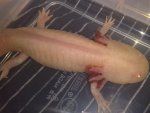Hi
My axolotl has been getting fat, and seems to keep gettting fatter! (attached photo)
Is this just from the eggs? If so, does she need anything special in the environment to induce her to release them? Will there be any problems if she keeps them too long?
How long does this process roughly last? A few weeks? A few months?
She is still producing a lot of waste... usually twice a day, so I don't think it's any digestion issue.
Also, she is eating a lot more than usual... She used to eat about 5 pellets a day, but now it seems she wants to eat a lot more if I keep feeding her (She stands with her head raised when waiting for food)....
Should I keep feeding her as much as she wants? the same amount? or even reduce it a bit?
cheers
My axolotl has been getting fat, and seems to keep gettting fatter! (attached photo)
Is this just from the eggs? If so, does she need anything special in the environment to induce her to release them? Will there be any problems if she keeps them too long?
How long does this process roughly last? A few weeks? A few months?
She is still producing a lot of waste... usually twice a day, so I don't think it's any digestion issue.
Also, she is eating a lot more than usual... She used to eat about 5 pellets a day, but now it seems she wants to eat a lot more if I keep feeding her (She stands with her head raised when waiting for food)....
Should I keep feeding her as much as she wants? the same amount? or even reduce it a bit?
cheers

